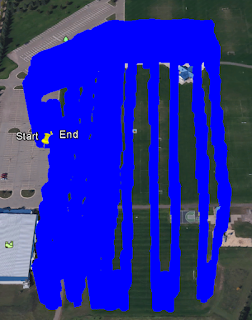Introduction: The focus of this activity was to work on our pre-flight process including device checks, filling out our pre-flight log and getting further familiar with the mission planning software. Fortunately, the weather cooperated and each team was able to successfully go through the entire process from start to finish.
Study Area: Conditions were ideal for flying and it did not rain until after we were done. Around a 5 mph wind and overcast clouds. For this exercise we went back out to the Eau Claire Sports complex and focused on the area featured below in (Figure 1).
 |
| (Figure 1) Eau Claire Sports Complex - shed is our primary focus |
This area is perfect for what we need, wide open with not a lot of obstacles and if timed right little to no people in the surrounding area. With flying these multi-rotors safety especially public safety is key. When operating these everyone has to be on the same page and be aware of what is going on in the area whether it be related to people, weather, disturbance in GPS signal, etc.
Methods: Before jumping right in to flying there are some crucial pre-flight steps needed to be done. This includes setting the GPS antenna (Figure 3) up high for best signal, going through the multi-rotor and assembling everything and beginning to do the pre-flight log. We used the same pre-flight checklist as the one found in my Activity 2 post (Figure 2). These checks are necessary for a number of reasons. The first being it is important to check all the hardware is in good working condition. The second being safety, if the area or conditions we are about to fly in are not good we cannot go through with the flight.
 |
| (Figure 2) Computer used for pre-flight log and Mission Planner |
 |
| (Figure 3) Pole used to get our antenna higher, the higher it is the less ground interference. |
 |
| (Figure 4) Matrix Multi-Rotor |
After doing the pre-flight checks we created a mission and sent it to the multi-rotor using Mission Planner (Figure 5). The missions all looked similar to the image below (Figure 4). For these flights we used the Matrix Quadcopter (Above Figure 4) with either the GEM sensor or the Canon SX260. With the sensors we still are focusing on having a high overlap (80%) to maintain the best quality processed image. Our flight times were around 4 minutes.
 |
| (Figure 5) Mission plan of area we imaged |
Discussion/Results: Although we haven't gotten to image processing yet there are two gifs below (Figure 6 & 6) to give you a basic idea of what the multi-rotor does while following the mission we sent it. The more we get opportunities to do the entire process the better we get. The teams were much more familiar with the entire process after going through it once a week earlier. Once the images are processed I will add them to this post.
 |
| (Figure 6) RGB Images taken with SX260 |
 |
(Figure 7) Near Infrared Images taken with SX20
|
Conclusion: The last two classes have been really important because they both have stressed the proper processes needed to do aerial imaging in the most effective, safe, and efficient way. With doing the pre-flight work and check lists it not only maintains the equipment better but helps catch problems that may occur during the flight and ultimately keeps everyone as safe as possible if done correctly. With the mission planner software it makes taking precise and well coordinated flights with imaging almost easy as long as you do the proper steps, make sure you are maintaining good GPS connection and if you are ready to take over if something goes wrong.
















